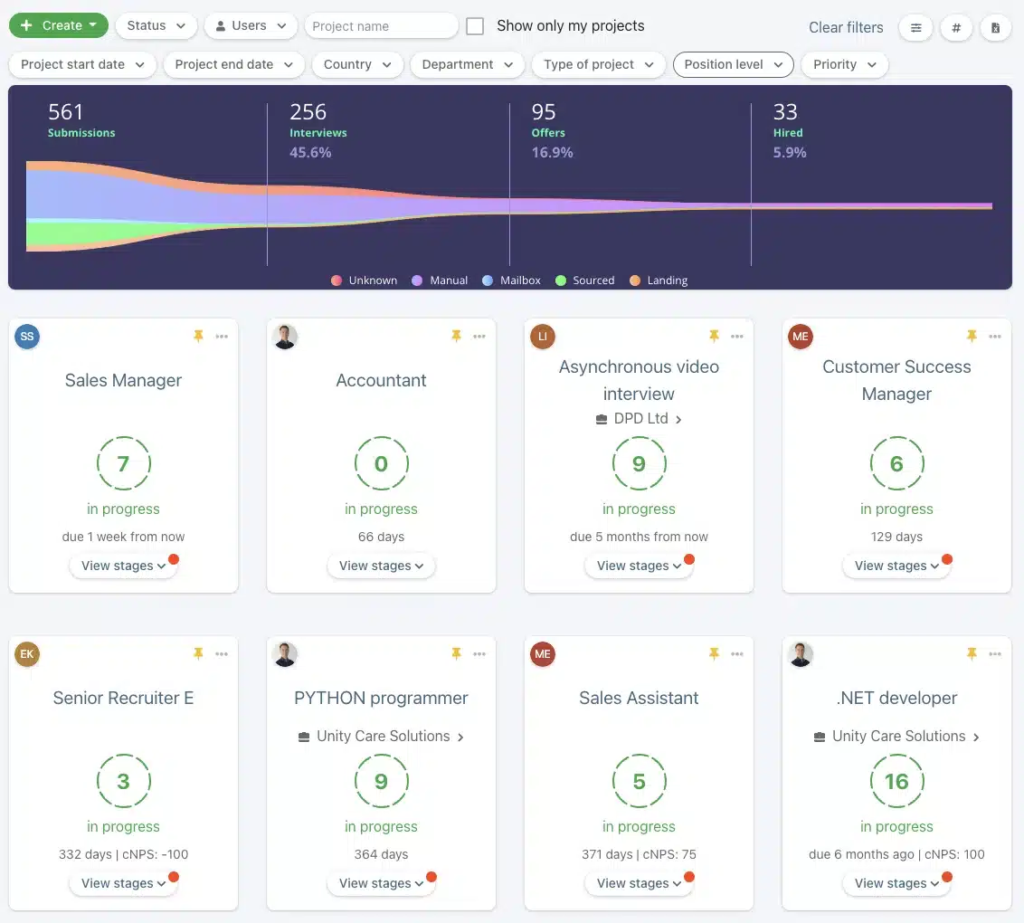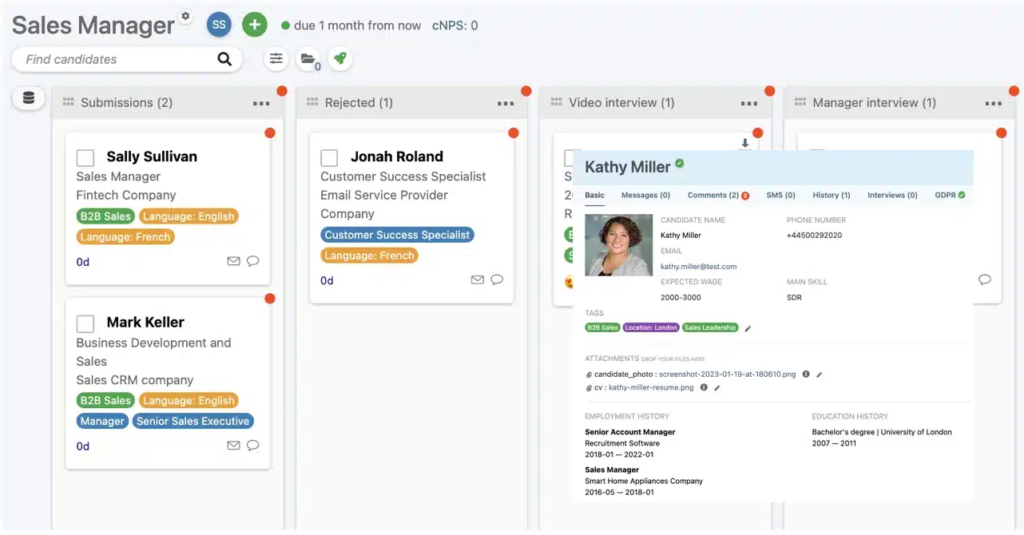From an outside perspective, it seems like recruiting new staff is a walk in the park for employers. One would think that all you have to do is flip through a couple of CVs, chit-chat with the applicants, and choose a suitable candidate.
But most companies’ recruitment process could be daunting and intensive, especially when filling a sensitive position.
Building an effective and result-driven recruitment process is crucial for companies that aim to develop a competent and effective workforce. Organisations need to streamline their recruitment process to attract top talents and become efficient from start to finish to get the best result.
Hiring an outstanding talent takes lots of planning, time, and effort. However, in the end, when done correctly, it’s often worth the investment because the organisation gets the right person they need to fill the role. On the other hand, a poorly planned hiring process could result in a high turnover rate, waste of resources, and, ultimately, hiring someone who doesn’t meet the requirements.
In the following article, we will explain in-depth the recruitment process steps your company can follow to get their ideal candidate.
What is a recruitment process?
A company’s recruitment process is a step-by-step process that the organisation goes through to identify, draw in and engage suitable candidates to fill their vacancy. It starts with identifying a position that needs to be filled. There are many reasons for a new position. To name just a few, it may be due to company expansion, retirement, or promotion of the person who formerly was on that position that could create a need for hiring.
After identifying the vacant position, the other recruitment process stages would include the following:
- Creating job requirements
- Sourcing candidates through job boards, social media, internal communications, etc.
- Screening and shortlisting candidates
- Making an offer
- Onboarding

How to build a recruitment process?
Depending on their specific needs, different organisations may have their unique recruitment process.
As an HR manager or recruiter, you must deeply understand your organisation’s needs before you can build an efficient recruitment process. You must also have a specific persona of the ideal candidate and a series of clearly-stated recruitment process steps to select that candidate.
Your recruitment process may be completely different for different positions, having a customisable funnel in your ATS makes your life easier and saves you time. For example, for some positions, using asynchronous video interviewing will do the trick, for some you need homework assignments or multiple stages of interviewing.

Recruitment process steps
The following are the most appropriate steps every organisation should follow for a seamless recruitment and selection process:
Step 1: Identify the vacancy
Kickstarting the recruitment process begins with spotting a vacancy – and this step is more than just ticking a box. It usually pops up when someone leaves, gets a promotion, or the company is growing and needs more hands on deck. But it’s not just about noticing a gap; it’s about understanding how this vacancy fits into the bigger picture. This is where team effort shines.
Departments need to huddle up and figure out not just the ‘what’ but the ‘why’ of this vacancy. Is it a chance to bring in fresh ideas, or to beef up an existing team? It’s all about being proactive, not just reactive. Identifying a vacancy is your chance to take a good look at where the company’s headed and how a new hire can help steer the ship in the right direction.
Step 2: Analyse the role and create a job description
Next up is getting down to the nitty-gritty of the role and crafting a job description that’s both clear and catchy. This step is where HR teams join forces with the department in need to get a crystal-clear picture of what the ideal candidate looks like. We’re talking skills, experience, the whole shebang. But it’s not just a laundry list of duties. This is about capturing the essence of the role – how it fits into the team, the kind of impact it has, and how it helps the company hit its goals.
You want to spark interest, not just lay out expectations. And let’s not forget the dough – setting a salary range that’s both fair and competitive is key. Do your homework on what’s out there in the market to make sure your offer is on point. This stage is all about setting the stage for attracting the kind of talent that doesn’t just fill a gap but brings something special to the table.
Step 3: Create a recruitment plan
Let’s talk about crafting your recruitment game plan. This step is where you figure out the best strategy to fill the vacancy. You’ve got options: maybe you want to give your current team a chance to step up through internal recruitment, or perhaps you’re looking to bring in some fresh talent from outside.
Now’s the time to choose your battlegrounds – are we talking job boards, the bustling world of social media, a referral program, or reaching out directly to folks with a solid track record? It’s all about finding the right fit for the role and your company’s culture. Budget and timeline are also key players here. You’ve got to set a realistic budget and a timeline that won’t leave the position hanging open for too long.
Don’t forget about the tech side of things. Automation can be a real lifesaver, taking the load off mundane tasks like sending rejection emails or scheduling interviews. It’s all about efficiency, so identifying which parts of the process can benefit from a tech touch-up is crucial. By the end of this step, you should have a clear, actionable plan that outlines how you’re going to find your next superstar.
Step 4: Post job ads to attract qualified candidates
Once your plan is locked and loaded, it’s time to put out the word with job ads (see some examples of job adverts). This is where you make your pitch to attract the crème de la crème of candidates. You’ve got a plethora of platforms at your disposal – think social media for its vast reach, job boards for their targeted audiences, and professional networking platforms for those in-the-know industry pros.
Choosing where to post your ads isn’t just a throw-it-at-the-wall-and-see-what-sticks situation. It’s about matching your ad to the right platform to reel in the kind of talent you’re after. The ad itself needs to be a head-turner – clear, engaging, and detailed enough to paint a vivid picture of what the role entails and what makes your company a great place to work.
This step is all about making your opportunity shine in a sea of job listings. It’s your first impression to potential candidates, so you want it to be a good one. Remember, it’s not just about filling a vacancy; it’s about finding someone who’ll add value to your team and mesh well with your company culture.
Step 5: Screening and shortlisting
Welcome to the filtering frenzy – screening candidates and shortlisting them. Once your job ad is out and applications start rolling in, brace yourself for an avalanche of resumes, especially if you are hiring for high volume roles. This stage is all about sifting through these applications to find the gems.
It’s time to get down to business with the resumes. You’re looking for candidates who don’t just meet the basic qualifications but also bring something extra to the table. If you’re swamped with top-notch applications (a good problem to have!), consider a preliminary screening. This could be a quick call or an online test to help you narrow down the field to those who truly stand out. Your application forms should also be designed to help you better screen through candidates.
Remember, this step isn’t just about ticking boxes in terms of qualifications and experience. It’s about peeling back the layers to see who these candidates really are and how they could fit into your team. You’re playing matchmaker here – between the job requirements and the candidates’ skills and personalities.
Step 6: Interviewing
The interview stage is where the rubber meets the road in the recruitment process. It’s not just a formality; it’s a critical juncture where you really get to know the candidates. For some roles, one or two interviews might do the trick to zero in on the ideal candidates. But when it comes to leadership, management, or other roles with high stakes, you might need multiple rounds to really gauge a candidate’s suitability.
In today’s world, interviews can take many forms. You could be meeting candidates face-to-face, catching up over a phone call, connecting via a video call, or even conducting asynchronous video interviews where candidates respond to your questions in their own time. Each format has its own nuances and can reveal different aspects of a candidate’s personality and skill set.
As an interviewer, you’ve got to be well-prepared. This means having a set of incisive questions ready to uncover candidates’ problem-solving abilities, technical expertise, cognitive skills, and what really motivates them. But it’s not just about what they know – it’s about how they think, react under pressure, and fit into your team’s culture. This stage is your chance to look beyond the resume and see the person behind the qualifications.
Step 7: Background and reference checks
Once a candidate has sailed through the interviews and emerged as a top contender, it’s time for some due diligence – background and reference checks (learn here how to perform a reference check). This step is crucial for validating the claims made by the candidate regarding their educational background, work history, and any professional certifications. It’s not just a box-ticking exercise; it’s about ensuring the candidate’s honesty and integrity.
Reaching out to references is also a key part of this stage. It’s your opportunity to get an outsider’s perspective on the candidate’s character, work ethic, and personality. What you’re looking for here is consistency – do the references’ insights align with what you’ve observed and what the candidate has claimed?
For certain positions, particularly those that are sensitive or involve a high level of trust, a criminal record check might be necessary. Transparency is key here – make sure candidates are aware of the checks you’ll be performing. This step is all about peace of mind, ensuring that the person you’re bringing into your organization is not just talented and qualified, but also trustworthy and reliable.
Step 8: Choosing the most outstanding candidate
After journeying through the recruitment process, you’re now at a critical juncture – picking the top candidate from a group of highly qualified individuals. This decision is complex and multifaceted. It involves a comprehensive evaluation of each candidate’s resume, academic qualifications, interview performance, evaluations, and skill-testing results. But it’s more than just comparing credentials; it’s about understanding who will best fit into your team’s culture and contribute to its success. Cultural fit is paramount in high-performing teams.
It’s essential to find someone who not only has the requisite skills but will also positively contribute to the team’s dynamic and the company’s broader objectives. With detailed analysis and team discussions, you’ll be able to discern the candidate who not only stands out in terms of skills and experience but also in their potential to enhance and enrich the team.
Step 9: Making an offer
Once you’ve identified the ideal candidate, the next step is extending a job offer. This critical stage is your first official point of engagement with your future employee. The offer should clearly outline the terms of employment, such as salary, benefits, start date, and other relevant conditions. It’s important to be prepared for negotiations at this stage, as candidates may wish to discuss aspects of the offer, including salary or benefits.
Typically, job offers are conveyed via email. This approach provides a clear, written record of the employment terms and allows candidates to carefully review and negotiate if necessary. Crafting a well-structured job offer email sets a professional tone for the nascent employment relationship and paves the way for a transparent and constructive dialogue.
Step 10: Onboarding
The final step in the recruitment process is onboarding. This phase is where the new employee transitions from being a candidate to becoming an integral part of your organization. Once the offer is accepted, it’s time for them to become familiar with the company’s policies, procedures, and culture.
Onboarding encompasses more than completing necessary paperwork such as employment contracts, tax forms, and confidentiality agreements. It’s an opportunity for the new employee to meet their colleagues, undergo any required training, and start integrating into their new role and the team. A smooth and well-planned onboarding process is essential. It not only helps the new employee feel welcomed and valued but also sets them up for success, laying the foundation for a productive and fulfilling work relationship.
Conclusions on building your recruitment process
Recruiting new staff is far more intricate than it seems from the outside. Each step in the recruitment process is crucial, from identifying the need for a new hire to seamlessly integrating them into the company. It’s a delicate balance of evaluating skills, ensuring cultural fit, and aligning individual potential with the organization’s goals. The journey involves not just sorting through resumes and conducting interviews but also strategic planning and decision-making. Whether it’s crafting a compelling job description, utilizing innovative recruitment methods, or conducting thorough background checks, each phase demands attention to detail and a deep understanding of the company’s needs.
The final stages, making a well-considered job offer and conducting a thorough onboarding process, are key to securing and successfully integrating a new employee. This is where investment in time and resources truly pays off, resulting in a team that is not just capable but also cohesive and aligned with the company’s vision.
Streamline your recruitment process with Teamdash
The recruitment process can be challenging even for the most experienced HR professionals, but you can simplify yours with Teamdash. Teamdash is an Applicant Tracking System designed to simplify and optimise your recruitment efforts.
With Teamdash, you no longer have to spend time going through manual paperwork, endless spreadsheets, and overwhelming candidate data. You can also easily track and measure your performance.
Teamdash automates the entire process so that you can focus on finding the right candidate who ticks all your boxes.
Teamdash – The all-in-one recruitment software.
Streamline your recruitment process, save up to 70% of your time and hire top talent fast.



